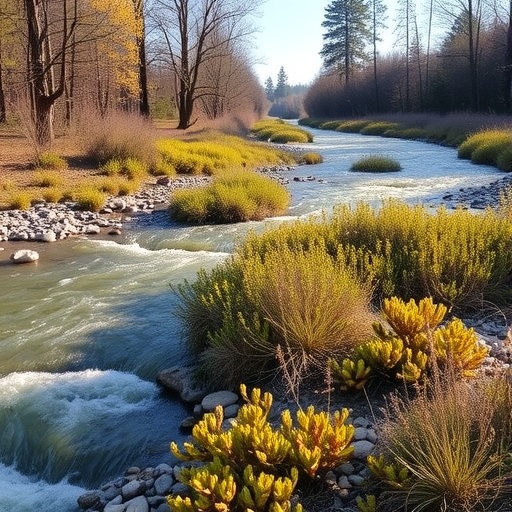For decades, the scientific community has accepted a foundational tenet about the evolution of Earth’s river systems: that the proliferation of land plants approximately 500 million years ago fundamentally altered the morphology of rivers, shifting them from predominantly braided channels to meandering forms. This long-standing paradigm suggested that vegetation played a crucial role in stabilizing riverbanks, thereby enabling the sinuous, single-channel meanders characteristic of many contemporary rivers. However, a groundbreaking study spearheaded by researchers at Stanford University is now compelling geologists and earth scientists to reconsider this narrative, proposing that the interpretations of ancient river sediments have been systematically misread due to oversimplified analogies to modern vegetation-influenced waterways.
The researchers’ work, soon to be published in the peer-reviewed journal Science, presents an extensive reexamination of how river channel shapes are interpreted in the sedimentary rock record. The current geological consensus holds that braided rivers—characterized by multiple interweaving channels separated by sandy bars—prevailed before the terrestrial colonization by plants. In contrast, meandering rivers, defined by a single, winding channel looping through floodplains, were thought to have emerged concurrently with plants, which helped to anchor sediments and reduce channel instability. This evolutionary ecological framework has influenced not only geology but also models of ancient carbon cycling and climate regulation.
Integral to the reinterpretation proposed is an innovative comparative analysis of approximately 4,500 river bends from a diverse array of contemporary rivers worldwide, encompassing both vegetated and unvegetated systems. The research deploys the focus on point bars—sandy depositional features forming on the inside bends of river meanders—as a critical diagnostic tool. Point bars migrate laterally due to sediment deposition influenced by water flow patterns, a process that actively sculpts the serpentine trajectory of meandering rivers. Crucially, the study reveals that in the absence of vegetation, point bars tend to migrate downstream, mimicking the sedimentary signatures traditionally attributed exclusively to braided rivers’ mid-channel bars.
This finding has profound implications. It suggests that ancient sedimentary records, which geologists had interpreted as evidence of braided rivers due to downstream bar migration angles, may in fact represent unvegetated meandering rivers. This fundamentally challenges the presumption that the rise of terrestrial plants was the primary driver of the meandering river form’s advent. Instead, meandering rivers lacking plant life could have been present much earlier in Earth’s history, potentially predating land flora by hundreds of millions of years.
Understanding this nuance is critical because the distinct river styles influence sediment storage, carbon sequestration, and nutrient cycling within floodplains. Meandering rivers foster extensive muddy floodplains, serving as substantial carbon reservoirs that regulate atmospheric carbon dioxide, a key greenhouse gas and planetary thermostat over geological timescales. If these floodplains—and their associated carbon capture capacities—existed far longer than previously posited, paleoclimate reconstructions and carbon modeling must be adjusted accordingly.
Lead author Michael Hasson, a PhD candidate in the lab of Mathieu Lapôtre at Stanford’s Doerr School of Sustainability, underscores the study’s revisionary impact: “Our results call for a redefinition of how we view the ancient Earth’s landscape. It appears that the sedimentary markers used to differentiate river types have been confounded by vegetation’s influence, or lack thereof. This advancement also hints at a more extensive duration of meandering river systems actively sequestering carbon in floodplains than formerly assumed.”
The research further calls into question the sedimentological assumption that bar migration directionality is an absolute proxy for river type. By documenting how vegetation alters not only sediment retention but also the geometric pathways of river bends, the study provides a refined interpretive framework to decode ancient geological formations more accurately.
The senior author, Assistant Professor Mathieu Lapôtre, emphasizes the pedagogical implications: “We’re demonstrating that a key principle taught in geosciences—that braiding equates to vegetation absence and meandering requires vegetation—is oversimplified. This paradigm risks misclassifying ancient fluvial deposits and thus misrepresenting Earth’s historical ecology and climate conditions.”
Methodologically, the team harnessed high-resolution satellite imagery and quantitative spatial analyses across diverse environments. They compared river systems ranging from lush vegetated basins to starkly barren, unvegetated streams. This extensive dataset provided an unprecedented empirical foundation to connect fluvial dynamics with vegetative cover quantitatively, enabling robust inference about sediment migration trajectories under variable ecological conditions.
These insights compel a reevaluation of Earth’s paleoenvironmental records. Accurate discrimination between ancient braided and meandering river deposits influences not only geological interpretations but also constrains models of sediment transport, landscape evolution, and organic carbon burial in floodplains. The presumed temporal boundary for meandering rivers—once believed to be coincident with land plant emergence—now appears nebulous.
Beyond pure geological and ecological theory, this research carries broader consequences for climate science. Atmospheric carbon dioxide concentration, governed in large part by the sequestration activity within floodplains and soils, modulates Earth’s climate feedbacks across eons. A misinterpretation of the spatial extent and longevity of such carbon reservoirs during Earth’s early epochs may distort our understanding of natural climate volatility and resilience, thus impacting future climate projections.
“Our findings highlight that reliable reconstructions of Earth’s past climate depend on meticulous reading of its sedimentary archives,” Hasson states. “Recognizing the widespread ancient existence of meandering rivers without vegetation changes how we evaluate natural carbon cycles and provides new context for the climate dynamics shaping Earth’s history—and likely its future.”
This study represents a significant stride toward integrating geomorphology, sedimentology, and ecological dynamics, unraveling the complex feedbacks between terrestrial vegetation and fluvial systems that have shaped Earth’s surface. It not only prompts revisions of textbook geology but opens avenues for reinterpreting ancient landscapes and the global carbon cycle with greater fidelity.
The research consortium also collaborated with institutions including the University of Padova and the University of British Columbia, further enriching the multidisciplinary approach essential to this transformative reinterpretation.
Subject of Research: Influence of vegetation on river channel morphology and sedimentary record interpretation
Article Title: Vegetation changes the trajectory of river bends
News Publication Date: 21-Aug-2025
Web References:
http://dx.doi.org/10.1126/science.adv4939
Image Credits:
M. Hasson and M. Lapôtre
Keywords:
Rivers, Geology, Geologic history, Erosion, Weathering




